Pediatric Ophthalmology (Video)
This is an introduction to pediatrics, created for our book OphthoBook. In this video, we cover all the basics of the pediatric eye exam, including:
- Checking Vision
- Retinoscopy Theory and Practice (animated videos!)
- Tropias versus Phorias (more animated video!)
- Amblyopia
- Leukocoria (including congenital cataracts and retinoblastoma)
- Retinopathy of Prematurity
Overall, I think this video came out quite well. The demonstration videos on retinoscopy and tropia/phorias are quite useful.
Screen Captures from this Video:
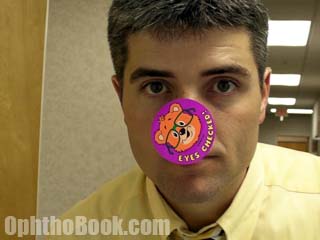
Children are difficult to check vision. Depending upon the age, a child may only blink-to-light, fix and follow, or even read pictures. Here are a couple of tips for checking a kids vision.
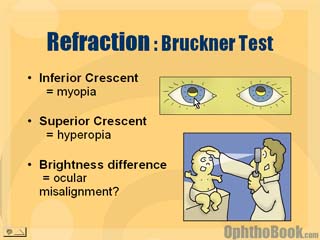
The Bruckner test is a way to estimate near-sightedness versus hyperopia.
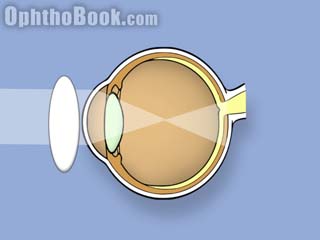
Retinoscopy is a difficult concept to understand. Here we explain how light focuses inside the eye, and how examining the red-reflex can help you estimate a child’s glasses prescription.
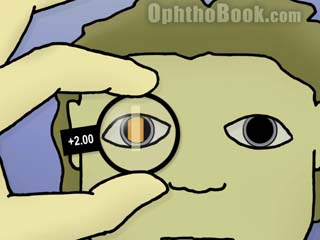
This animated sequence shows the “with” motion you get. It then procedes to show the correct red-reflex you should see, followed by the over-corrected “against” motion.
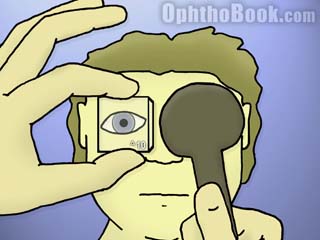
This animated sequence shows the difference between a tropia and a phoria. Also, the cover-uncover and cross-cover tests are demonstrated. Finally, you’ll learn how to correct deviation using prisms.
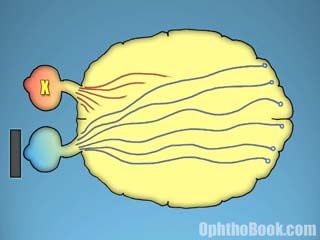
This animation shows the wiring involved with amblyopia, and why we patch eyes to correct vision.
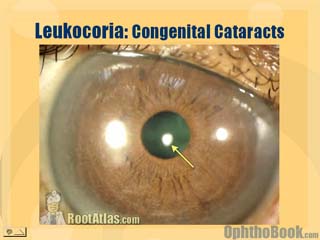
Leukocoria (a white colored pupil) can be an emergency. In this case, it is caused by a small congenital cataract.
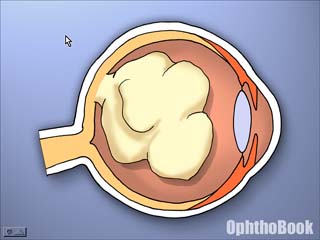
Retinoblastoma is a more serious cause for a white pupil. This cancer can kill if it tracks down the optic nerve.
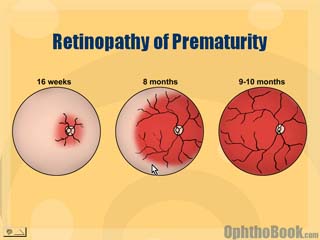
The video concludes with an explanation for ROP (retinopathy of prematurity) … what causes it, and why we perform laser to treat it.
Thanks for making these great videos,I’m starting to like a field of medicine I used to think was so boring.. 🙂 Thanks!
Since I’m European, I couldn’t help but notice a small mistake on the “indications for screening” slide; you might wanna change 1500 kg to 1500 GRAMS, otherwise we’re talking about a giant of a baby 😉
Keep up the good work!
Best regards, Anna (5th year medical student)
excellent demonstration
Amazing demonstration. Please allow download
This has been such a wonderful learning tool. I’ve worked in ophthamology for two years and groan when I get a baby or small child because I just didn’t know much about how to examine them or what a doctor was looking for. I’ve learned so much from your videos. Thank you so much.
Thanks for this excellent resource! I am a 3rd year Family Medicine resident and especially like the cartoons and live videos showing exam techniques and findings. This is better than our ophtho rotation!
Thank you soooo much. I spent 2 hours watching your videos, they are very helpful.
IMG
very impressive & very useful! thanks!
very good video, just one point, at 21.17 its the old metric system and i hope it should be 1500 grams not kg lol
Lott of Thanks TheVideo Not Open AtAll
Please The Vedio Not open AtAll
NafesaSaid, it’s working on my end! I can see the video on my computer. Do you have flash video installed, and can you normally watch videos like YouTube?
excellent demonstration! thank you.
i appreciate ur effort
Thank u so much…i have really started enjoying optho now…U r a genius!
Bravo! As someone who works on early identification of visual abnormalities at children every day I can say THANK YOU!
how can i download this video its not in the youtube….
Well you rock, thanks Doctor for this great work, it is very useful and interesting. I hope that you can work on a lecture about ROP dealing with it in more depth.
2nd year resident in ophthalmology Russia, Kursk state medical university.
I enjoy the VDO very much. There is only one point I would like to correct about the slide of ROP screening. The birth weight should be 1500 grams, not kg.
Thanks.
sorry/vidio did not open at all.
vidio not open atall
far better den d technical jargon used in common medical textbook…. kp d gud work going…
Really thank u very very very much
thanx alot for the effort , i found these videos very helpful and concise, keep up the good work
A.amoudi saudi arabia
Great video lecture! Thanks for posting!
Hello,
I just have a comment on Hirchberg test. I’ve learnt that 1 mm is actually 22 prism dioptres, not 15 prism dioptres.
Editors Note: Thanks for writing V. I believe that 15 prism diopters (as mentioned in this video) is correct. According to the “Pediatric Ophthalmology and Strabismus” book put out by the AAO, the Hirschburg test shows that 1mm of light decentration corresponds to about 7 degrees or 15 prism diopters of deviation. I’ve listed the source below. If you know of another source that states 22diopters, let me know. Thanks!
Source Quoted: “Simon JW, Calhoun JH. A Child’s Eyes: A Guide to Pediatric Primary Cre. Gainesville, FL: Triad Publishing Co; 1997:72.)
videos and theory presented by you are excellent tool to refresh for practicing ophthalmologist also. You have done a excellent job for the education of ophthalmologist and students across the world.
I recently stumbled on your website when I was searching a video about opthalmology and let me say thank you for your courage, determination and hard work in making ophthalmology simple using animated video. however I found minor error in the slide of the video that shows a risk factors for retinopathy of prematurity that indicate 1200 kilogram of an infant being at risk of prematurity.Please can you look at it and make a correction. My ancestor used to say only a functioning human can make errors.
Thank you again.
As a relatively new early childhood nurse working alone in a clinic your videos and demonstrations were excellent! So thank you very much from Wollongong NSW Australia!
dr root u hv done a wonderful job . its simply rocking. my request is if u cud put more of such educative videos . thnx
Thank u excellent video
Thanks! What a great video on peadiatric eye examination, something I never quite got until I watched this very informative but simple clip. I will not dread peads eye examinations again!
Hi amazing video I am going into optometry but I was just curious as to why not just cover a child’s eyes if they are born premature until they are 9 months and fully developed instead of using the laser 1000 times to create holes in the peripheral retina.
thank you very much!!! i finally understood retinoscopy (im kinda lazy to read) i couldn t watch you video in my mac (dont know why)but i tried in every computer i had in front of me and it worked in a pc with windows (¿?) thxs again
I enjoyed your video doctor, very useful for my upcoming Pediatric presentation at work. I am looking forward to more educational videos. Thank You.
Thank you very much such a wonderful and helpful video (Pediatric Ophthalmology Video). Is it permissable to translate it into other languages in order to increase the awereness of both public and medical doctors.
It is wonderful.how can I download it nand sve it
thanks& regards
i have problem with my son retina, ROP, laser had done at 20 january 2011. And now have bleeding, what can i do? please help to explaine ROP and what the solution.Thank you very muc
excellent. thanks for effort.
Hi Dr Root,
Love your work. It takes a lot of intelligence and forethought and make things seem so simple as you do!
I don’t know whether you appreciate typo’s being pointed out for future presentations/version or would rather we didn’t mention them …. but pediatric opthalmology video 21.30 ‘What babies get screened’ slide on retinopathy of prematuraty
Hey Dr. Root thanks so much for all these very informative videos. I wanted to know if you knew the reason of why in the bruchner test, inferior crescents indicate myopia and superior crescents hyperopia. Thanks!
Excellent! Your sharing effort on Pediatric Ophthalmology is greatly appreciated. Thanks from Malaysia.
great job
keep it up.
Thanks so much for publishing this excellent series of video lectures and resource materials.
However, I feel obliged to point out that 1500kg is not “pretty darn small”! 1500kg is pretty darn huge!
(1500g (grams) is pretty darn small…)
Simple, clear and very useful.
Thanks a lot from Chile
great effort i always like these kind of vedeos soft style
niiiiiiiccccccceeeee
Hi Dr Root
The website is amazing and I found all the videos are very informative. It helps me to learn as a junior ophthalmologist.
In this video 2min30sec, i guess u mean 1500g for baby needing screening not 1500kg 🙂
Anyway, Fantastic work and I look forward to all your new videos/ lectures
Your way of teaching and presentation are superb. Thank you alot for sharing your knowledge.Thanks from India.
this is the best presentation i ever seen , thank you
Ehab
optometrist
wonderful video will help all practitioners in clinics testing kids
very simple and clear especially for undergraduates 🙂
its wonderful!
My students told me to come check out your website and they were right!
GREAT teaching resource…..thank you so much for showing students the FUN of our fascinating subject 🙂
me gustan mucho tus videos, soy optometra en colombia y me parece una buena tecnica audiovisual para el aprendizaje.
felicidades
thank you,good lecture.
hi,
can u plz help me iam not able to watch your videos, your videos are not able to load
great videos sir,
i say your videos are just amazing ,simple yet very practical. like to see some videos on contact lens fitting.
Ameen Rahman
Msc(optometry)
dr.root ,u have done a wonderful job by making these great videos .they r very informative ,illustrative,simple to learn and amazing..good n useful for all in ophthalmology dept..sharing knowledge is the greatest thing about you ..i am a real fan of you.
Wonderful videos..
plus you are cute too.
Hence because you are cute (very very attractive), its more easier to learn opthalmology now..
thank you sir , amazing website . I would like to express my thanks and deep appreciation .
i am from Brazil , Recife south america and i think that these videos are a lot of fun to learn with.
and very informative for the none ophtho resident. i am a resident in ophtho and i am starting to think that they are pretty basic so i am kind of finding it very hard to follow this time. so I wonder aren’t you going to have a session for residents in ophthalmology here? at anyrate;thanks for sharing that with us down here in Brazil.
yours truly,
claudioagmfilho.
Hi, I’m from Madagascar and I’m an ophthalmic nurse trained in the Gambia. We are setting up our own ophthalmic nursing school so I’m looking for more educational tools like video, may you help me to have your video in a CD please, and if you have some others teaching materials can you help us to get some of them. Many thanks in advance. you can contact me on my email address.
Hi, I’m from Madagascar and I’m an ophthalmic nurse trained in the Gambia. We are setting up our own ophthalmic nursing school so I’m looking for more educational tools like video, may you help me to have your video in a CD please, and if you have some others teaching materials can you help us to get some of them. Many thanks in advance. you can contact me on my email address.
Best wishes
You are really good at this doc.
you videa is very intersting! could you teach me about phoroter?
very nice so nice of ur work keep it up……
Amazing explanation!!! thank you so much.
I hope you can help me how to use schematic eye in retinoscopy training. Also how to use retinoscopy in astigmatism and unastigmatism cases. Thaks alot for your help.
Hi Dr,
I am from China. You did a great work for all the ophthalmologist.
Thank you so much!
Awesome…. as usual! Thanks for producing this video!
HEY I just watched your videos and think they are amazing although I did notice that under the screening process for retinopathy of prematurity it has less than 1500 kg.
do you mean grams?
1 kg = 2.2ish pounds.
THANK YOU. I’ AM A 2 YEAR STUDENT IN OTOMETRY AND THIS VIDEO WAS VERY HELPFULL, THANKS FROM TEL AVIV, ISRAEL
thanks …….your video helped me alot
very informative video. thanks
Dear Dr. Root,
Thank you SO MUCH for your web resources and your book!!! Ophthalmology would have been so much more confusing without your help!
Thanks x n!
Med student
Wonderful…as a pediatrician it helped me a lot.
Please continue this excellent job
Dear Dr. Root,
Could you please explain the reasoning behind why myopia/hyperopia give an inferior/superior crescent on red reflex testing?
Thanks!
Thank you
very helpful…thanks
Good explanation.
Now i know what to expect from my ROP baby 🙂
Thanks from MALAYSIA 🙂
u r very talented, great videos, great teaching …
as a GP , struggling with eye examination
really good source recommended to my colleagues
all the best
thank you sirthis is one of the best lecture for opthomology
You are so Cute!